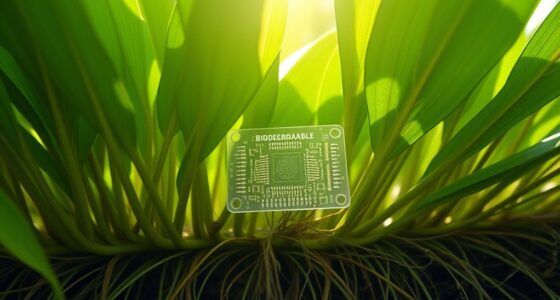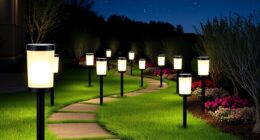Passive solar greenhouses help you grow food in Arctic winters by capturing and storing sunlight’s warmth through strategic design and insulation. You can maximize heat with south-facing windows, thermal mass, and reflective surfaces that bounce light inside. Advanced insulation keeps temperatures steady, while energy-efficient lighting extends daylight hours. These greenhouses improve food security and community resilience. Keep exploring to discover how these innovative solutions can transform Arctic agriculture and make year-round food production possible.
Key Takeaways
- Passive solar greenhouses utilize thermal mass, insulation, and strategic orientation to maximize heat retention during Arctic winters.
- Double-glazed panels and insulated walls minimize heat loss, maintaining stable temperatures for year-round crop growth.
- Proper window placement and reflective surfaces enhance sunlight capture and distribution inside the greenhouse.
- Renewable energy systems support supplemental heating, ventilation, and lighting, reducing reliance on external power sources.
- Compact designs and modular systems extend the growing season and improve crop yields in harsh Arctic conditions.
Understanding the Arctic Climate and Its Challenges

Have you ever wondered what makes the Arctic climate so challenging for agriculture? One key factor is the stability of the permafrost, which remains frozen year-round and prevents deep-rooted crops from thriving. Thawing permafrost can lead to ground instability, making farming difficult and damaging structures. Additionally, polar wind patterns sweep across the region with high speeds, increasing heat loss and lowering temperatures even further. These persistent winds also cause soil erosion and complicate efforts to maintain a stable environment for plant growth. Moreover, effective fraud prevention tools in transaction processing can be crucial for supporting remote Arctic agricultural ventures by securing financial transactions. Together, the permafrost’s stability and polar wind patterns create a harsh, unpredictable climate that demands innovative strategies for sustainable agriculture. Understanding these elements helps you grasp why traditional farming methods struggle in Arctic conditions.
Principles of Passive Solar Design for Cold Environments
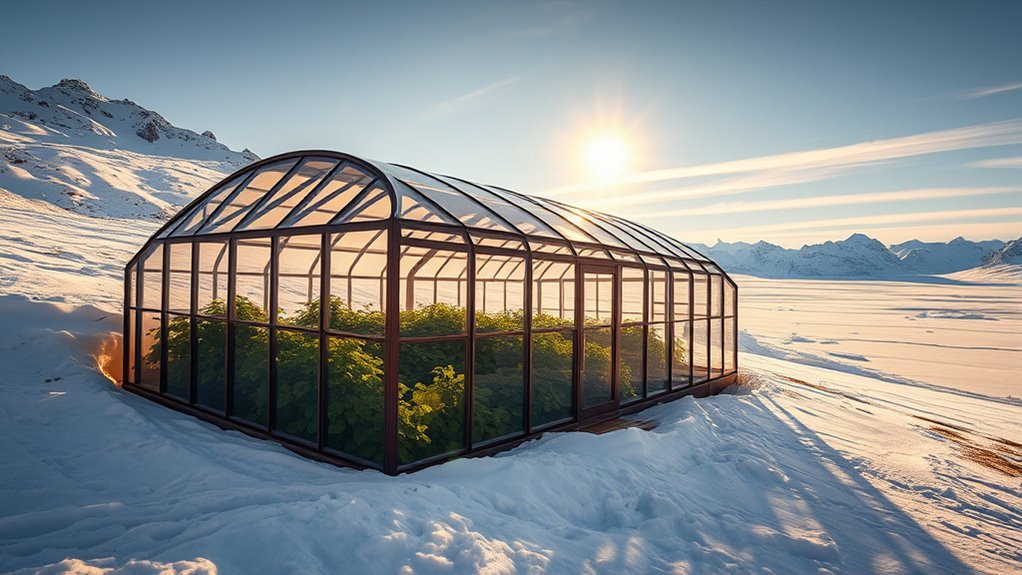
Building on the challenges posed by the Arctic’s extreme climate, passive solar design offers practical solutions to maximize heating with minimal energy input. You harness thermal mass—like rocks or concrete—to absorb daytime heat and release it at night, maintaining stable temperatures. Natural ventilation ensures fresh air circulation without losing heat, reducing reliance on mechanical systems. Proper orientation of your greenhouse toward the sun captures maximum sunlight, especially during winter months. Insulation minimizes heat loss, while strategic window placement enhances solar gain. Here’s how these principles come together: climate considerations
| Principle | Purpose | Effect |
|---|---|---|
| Thermal mass | Stores heat | Stabilizes indoor temperature |
| Natural ventilation | Air circulation | Maintains fresh, warm air |
| Proper orientation | Maximizes sunlight | Boosts passive heating |
| Insulation | Reduces heat loss | Keeps warmth inside |
| Window placement | Enhances solar gain | Raises indoor temperature |
Key Components of a Passive Solar Greenhouse
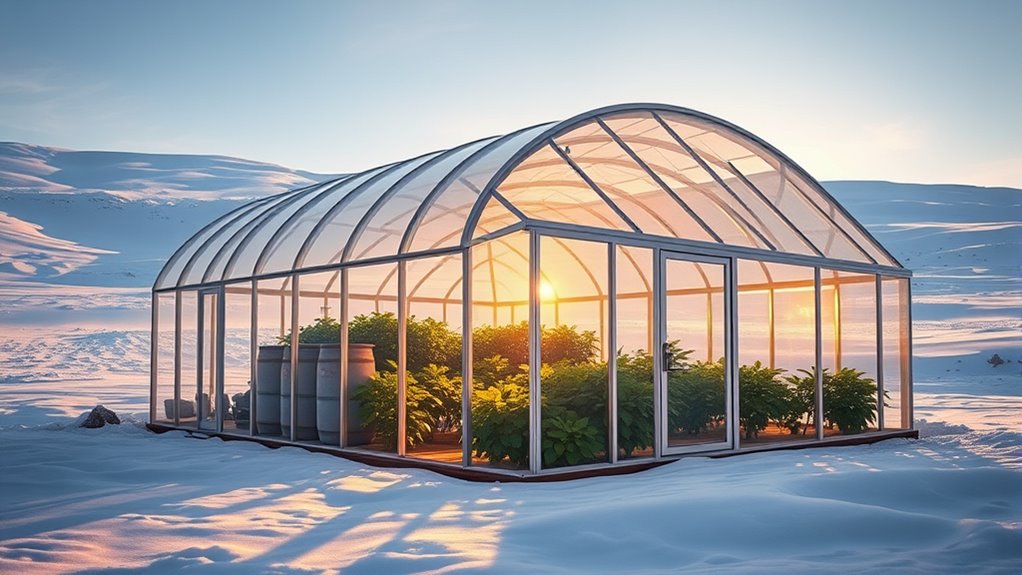
A passive solar greenhouse relies on several key components that work together to maximize solar gain and retain heat. These include the building’s orientation, south-facing glazing, thermal mass, and heating systems. You might visualize large, transparent panels that absorb sunlight, walls made of concrete or stone storing heat, and a carefully positioned hydroponic system that benefits from the warmth. Compost heating plays a vital role by generating additional warmth through decomposing organic matter, reducing reliance on external energy sources. Other components include ventilation to prevent overheating and insulation to minimize heat loss. Integrating specialized planters can further optimize plant growth by providing tailored environments. Together, these elements create an efficient environment, ensuring plants stay warm and thrive even during frigid Arctic winters.
Materials and Insulation Techniques for Extreme Cold
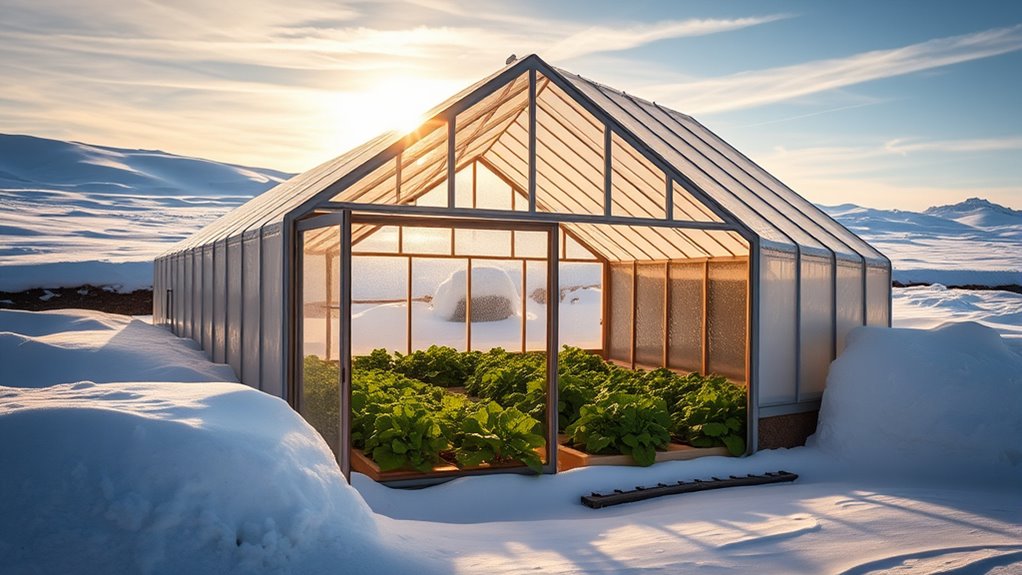
To keep your greenhouse warm in extreme cold, choosing the right insulation materials is essential. You’ll want to think about options like double-glazed panels or insulated walls to maximize heat retention. Additionally, applying effective construction and design techniques can greatly improve your greenhouse’s ability to withstand harsh winter conditions. Considering AI safety measures in your planning can help prevent potential operational issues in automated systems used for climate control.
Insulation Material Choices
Choosing the right insulation materials is essential for maintaining warmth in passive solar greenhouses during extreme cold. Your goal is to select effective insulation material choices that serve as reliable thermal barrier options. These materials reduce heat loss and enhance energy efficiency in frigid environments. Consider options like rigid foam boards, which provide high insulation value with minimal thickness; reflective foil insulation that bounces heat back inside; spray foam for seamless, airtight coverage; and insulated panels designed specifically for extreme cold. Visualize layers of foam, reflective surfaces, and sealed joints working together to trap heat. Your choice of insulation material impacts the greenhouse’s ability to keep plants alive through harsh winters, ensuring consistent warmth and ideal growing conditions. Incorporating best insulation options for low temperatures can further optimize thermal retention.
Construction and Design Tips
Effective construction and design are essential for maximizing insulation and thermal performance in passive solar greenhouses during extreme cold. To achieve this, focus on airtight seals and high-quality insulation materials, especially around windows and structural joints. Incorporate solar panel integration into your design to harness renewable energy for supplemental heating, reducing reliance on external sources. Your interior layout should prioritize maximizing sunlight exposure, with strategic placement of plants near south-facing windows. Use reflective surfaces to distribute light evenly and minimize heat loss. Consider incorporating thermal mass elements like water barrels or stone floors to store heat during the day and release it at night. Properly designed, your greenhouse will stay warmer longer, even in harsh Arctic winters, supporting healthier plant growth. Additionally, selecting insulation materials with high R-values can significantly improve thermal retention and overall energy efficiency based on insulation properties.
Solar Gain Optimization and Heat Retention Strategies
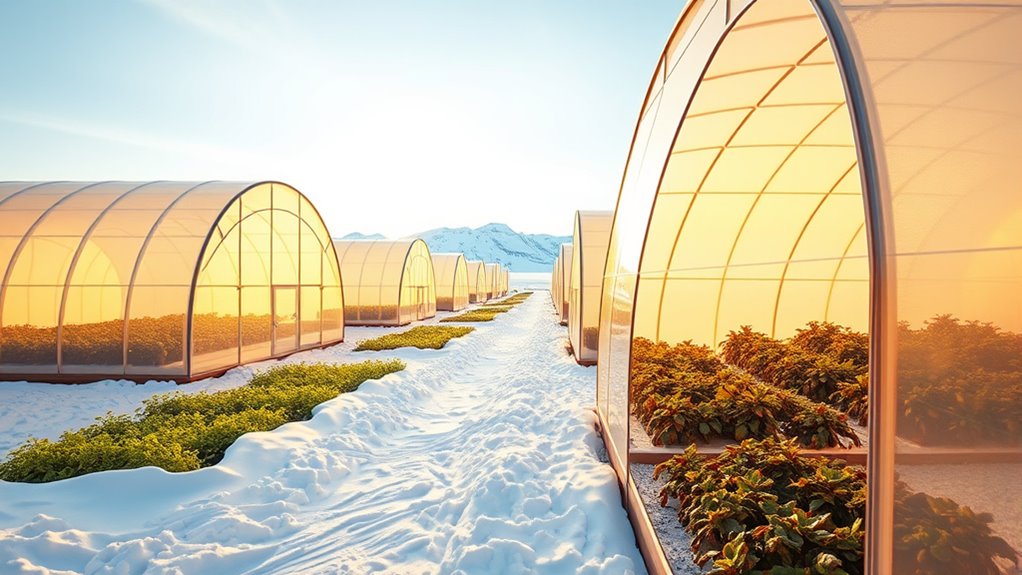
Maximizing solar gain and retaining heat are essential for the efficiency of passive solar greenhouses. You can achieve this by strategically using thermal mass, like water barrels or concrete floors, to absorb heat during the day and release it at night. Proper shading techniques, such as overhangs or deciduous plants, prevent overheating during the warmest hours. Insulating south-facing walls minimizes heat loss, keeping warmth inside. You might also consider glazing with high R-value materials to trap more heat. Additionally, sealing gaps and using draft stoppers prevents cold air infiltration. These combined strategies ensure your greenhouse captures maximum sunlight and retains heat, allowing you to grow food reliably in Arctic winters. Visualize sunlight streaming in, thermal mass warming the space, and insulation locking in every degree. Incorporating electricity production from bike generators can also generate supplemental power for heating systems or grow lights during long winter nights.
Managing Light and Day Length in Polar Regions
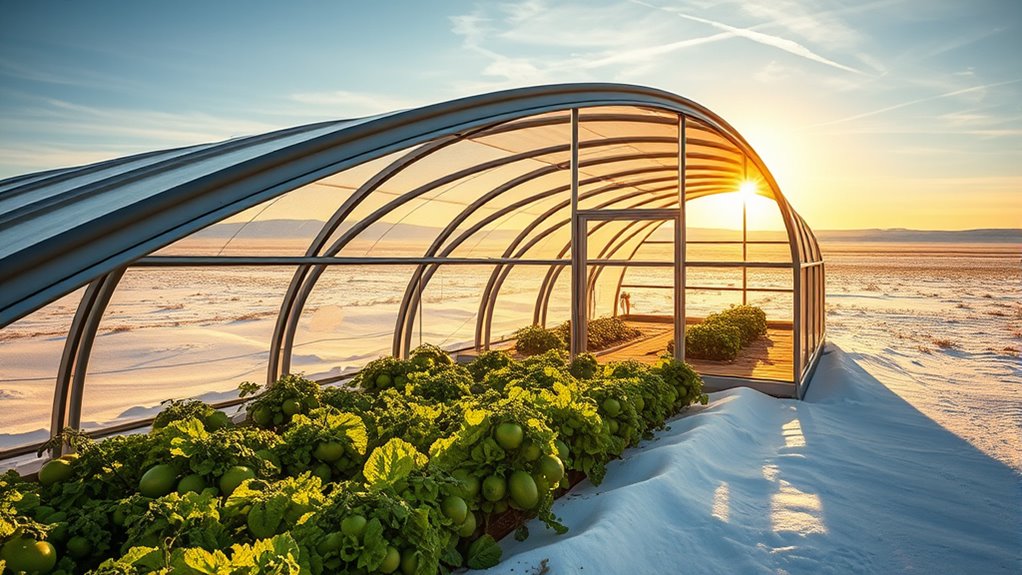
In polar regions, managing light effectively is essential for year-round plant growth. You can optimize sunlight by using reflective surfaces and strategic shading, ensuring plants receive the right amount of light. Controlling daylight duration through automated systems helps maintain consistent conditions despite natural variations. Implementing light management techniques can further enhance plant health and productivity in these challenging environments.
Light Optimization Strategies
Managing light and day length in polar regions presents unique challenges for passive solar greenhouses. To optimize available sunlight, you can incorporate solar tracking systems that gently shift the greenhouse’s orientation, maximizing light capture throughout the day. Understanding plant photoreceptors helps you tailor lighting conditions, ensuring plants receive the right signals for growth despite limited natural light. Use reflective surfaces inside to bounce sunlight into shadowed areas, creating a more uniform light distribution. Additionally, strategic placement of translucent materials allows more sunlight to penetrate, reducing dark spots. These strategies help you make the most of scarce winter daylight, supporting healthy plant development even in extreme conditions. Incorporating beneficial ingredients like collagen and hyaluronic acid can also enhance plant resilience and growth in challenging environments. Together, solar tracking, photoreceptor awareness, reflectors, and smart materials enable efficient light utilization in Arctic greenhouses.
Daylight Duration Control
Controlling daylight duration in polar regions requires careful planning since natural light cycles can be extremely limited or irregular. To maximize plant growth, you can supplement sunlight with artificial lighting, adjusting it to match crop rotation schedules. Using solar panels on your greenhouse roof can generate power for LED grow lights, reducing energy costs. Implementing a crop rotation system ensures plants receive ideal light exposure throughout the winter. Consider this table:
| Time of Day | Light Management Strategy |
|---|---|
| Morning | Use reflective surfaces to maximize daylight |
| Afternoon | Extend daylight with supplemental grow lights |
| Night | Maintain consistent light cycles with automation |
Additionally, incorporating light regulation techniques can optimize plant development and energy efficiency during extended winter months.
Case Studies of Arctic Passive Solar Greenhouses
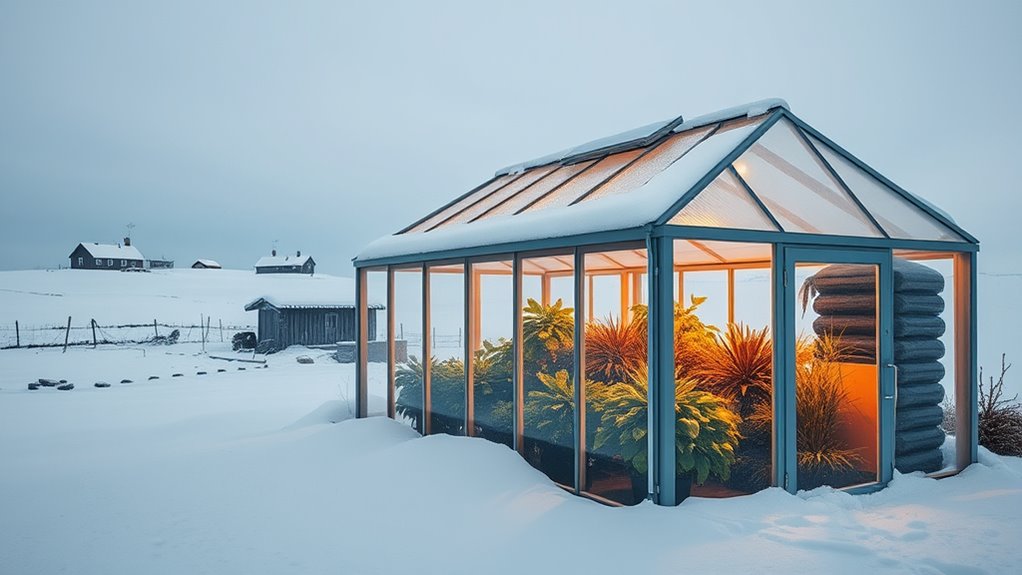
Despite the extreme conditions, several Arctic communities have successfully implemented passive solar greenhouses to extend their growing seasons and improve food security. These greenhouses foster arctic flora that can thrive despite cold temperatures, enabling winter harvesting. You can imagine vibrant greens contrasting against snow, with sunlight warming the interior. In these case studies, communities use thick insulation and strategic glazing to maximize solar gain. The greenhouses often feature:
- South-facing windows capturing every sunbeam
- Insulated walls retaining heat during long, dark winters
- Compact layouts minimizing heat loss
- Renewable energy sources supporting ventilation and lighting
These innovations allow residents to grow fresh vegetables and herbs, transforming barren landscapes into productive gardens that sustain them through the harshest months.
Benefits for Local Communities and Food Security
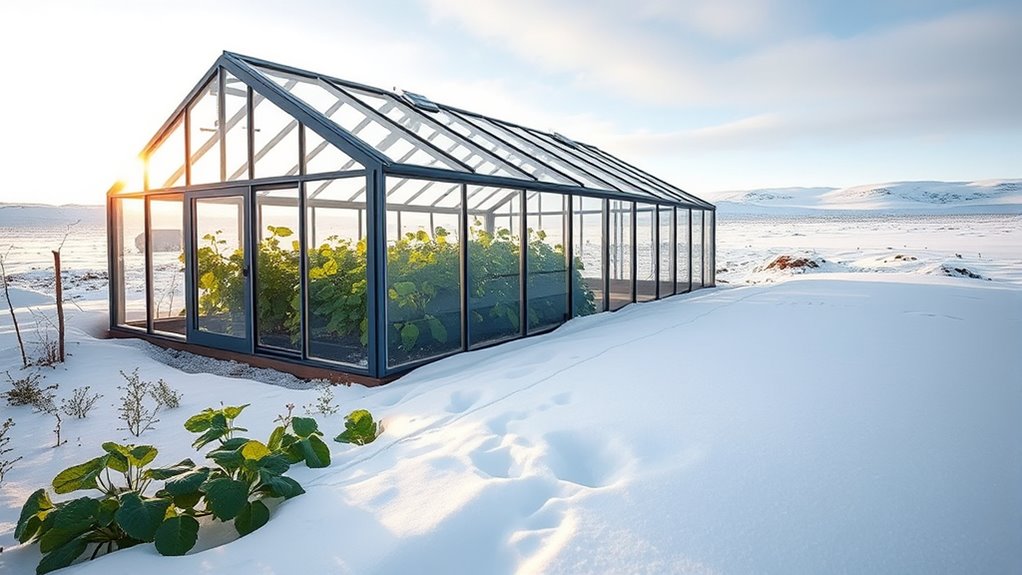
Have you ever considered how passive solar greenhouses can transform a community’s access to fresh food? They enable urban farming in remote Arctic areas, reducing dependence on imported produce. By integrating hydroponic systems, communities can grow vegetables efficiently year-round, even during harsh winters. This boosts local food security, especially when outdoor growing isn’t possible. Greenhouses also foster community engagement, providing opportunities for residents to participate in food production and learn new skills. With increased local food production, families save money and gain access to healthier options. Additionally, these greenhouses can create jobs and stimulate local economies. Overall, passive solar greenhouses strengthen resilience, improve nutrition, and help Arctic communities thrive despite challenging environmental conditions.
Future Prospects and Innovations in Arctic Agriculture
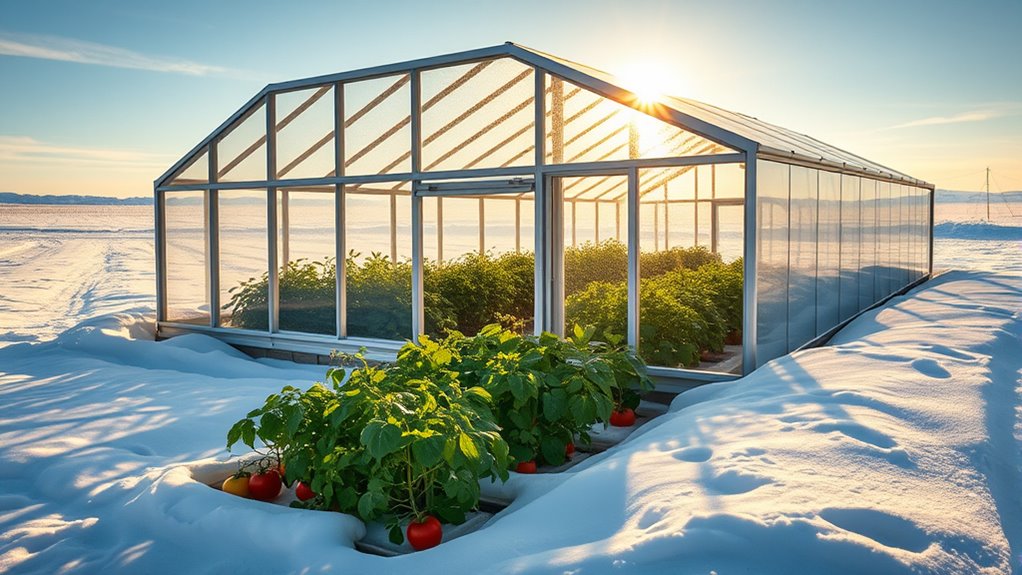
Advancements in passive solar technology and renewable energy sources are paving the way for innovative approaches to Arctic agriculture. You can expect to see more efficient hydroponic systems that maximize space and reduce water usage, perfect for harsh climates. Renewable energy integration, like solar panels or wind turbines, will supply power for indoor farming without relying on fossil fuels. Future innovations may include insulated greenhouses that trap heat naturally, extending growing seasons further. Imagine transparent walls that optimize sunlight while maintaining warmth, or modular systems that adapt to changing conditions. These advancements will enable sustainable food production in the Arctic, reducing reliance on imports and boosting local resilience. As technology evolves, Arctic agriculture will become more productive, resilient, and energy-efficient.
Frequently Asked Questions
What Are the Cost Implications of Building Passive Solar Greenhouses in the Arctic?
Building passive solar greenhouses in the Arctic involves significant initial investment due to specialized materials and insulation needed for extreme cold. However, you’ll save on operational costs because they rely on natural sunlight and minimal energy inputs. While upfront expenses are higher, long-term savings are notable since you reduce energy consumption and maintenance costs. Overall, though the upfront costs are substantial, the low operational costs make passive solar greenhouses a cost-effective solution over time.
How Do Passive Solar Greenhouses Impact Local Wildlife and Ecosystems?
You might wonder how passive solar greenhouses affect local wildlife and ecosystems. They generally cause minimal wildlife disturbance because they blend into the environment and don’t require extensive land alteration. However, they can influence ecosystem balance by attracting certain species and modifying natural habitats slightly. It’s crucial to take these impacts into account to ensure the greenhouses support sustainable coexistence, protecting local flora and fauna while providing fresh food in harsh Arctic conditions.
What Maintenance Challenges Are Unique to Arctic Passive Solar Greenhouses?
You might worry about maintenance challenges in Arctic passive solar greenhouses, especially during harsh winters. Permafrost stability can be affected by soil warming, risking structural issues, while insulation degradation occurs faster due to extreme temperatures and wind. To keep things running smoothly, you need regular inspections, effective insulation repairs, and monitoring of permafrost conditions. Staying proactive helps prevent costly damage and ensures your greenhouse remains a reliable food source despite the extreme environment.
Can Passive Solar Greenhouses Support Year-Round Crop Varieties?
You can support year-round crop varieties by focusing on seasonal crop selection and plant adaptation strategies. By choosing crops suited to your environment and implementing techniques like selecting hardy varieties or adjusting planting schedules, you optimize growth. Passive solar greenhouses help maintain stable temperatures, making it feasible to grow diverse crops year-round. This approach allows you to maximize productivity despite seasonal changes, ensuring a continuous supply of fresh produce.
How Scalable Are These Greenhouses for Larger Community Food Production?
You wonder how scalable passive solar greenhouses are for larger community food production. While they offer great potential, community integration and scalability challenges exist. As you expand, you’ll need to contemplate climate control, resource management, and infrastructure costs. Building connected greenhouses can enhance efficiency, but it requires careful planning. Overall, with proper design and community support, these greenhouses can become a sustainable way to boost local food security.
Conclusion
By harnessing passive solar design, you can grow fresh food even during the harsh Arctic winters. These greenhouses can extend the growing season by up to six months, providing essential food security for remote communities. With innovative insulation and solar strategies, you’ll see a significant reduction in energy use—up to 80% compared to traditional greenhouses. Embracing these methods not only sustains local life but also paves the way for future Arctic agriculture.





